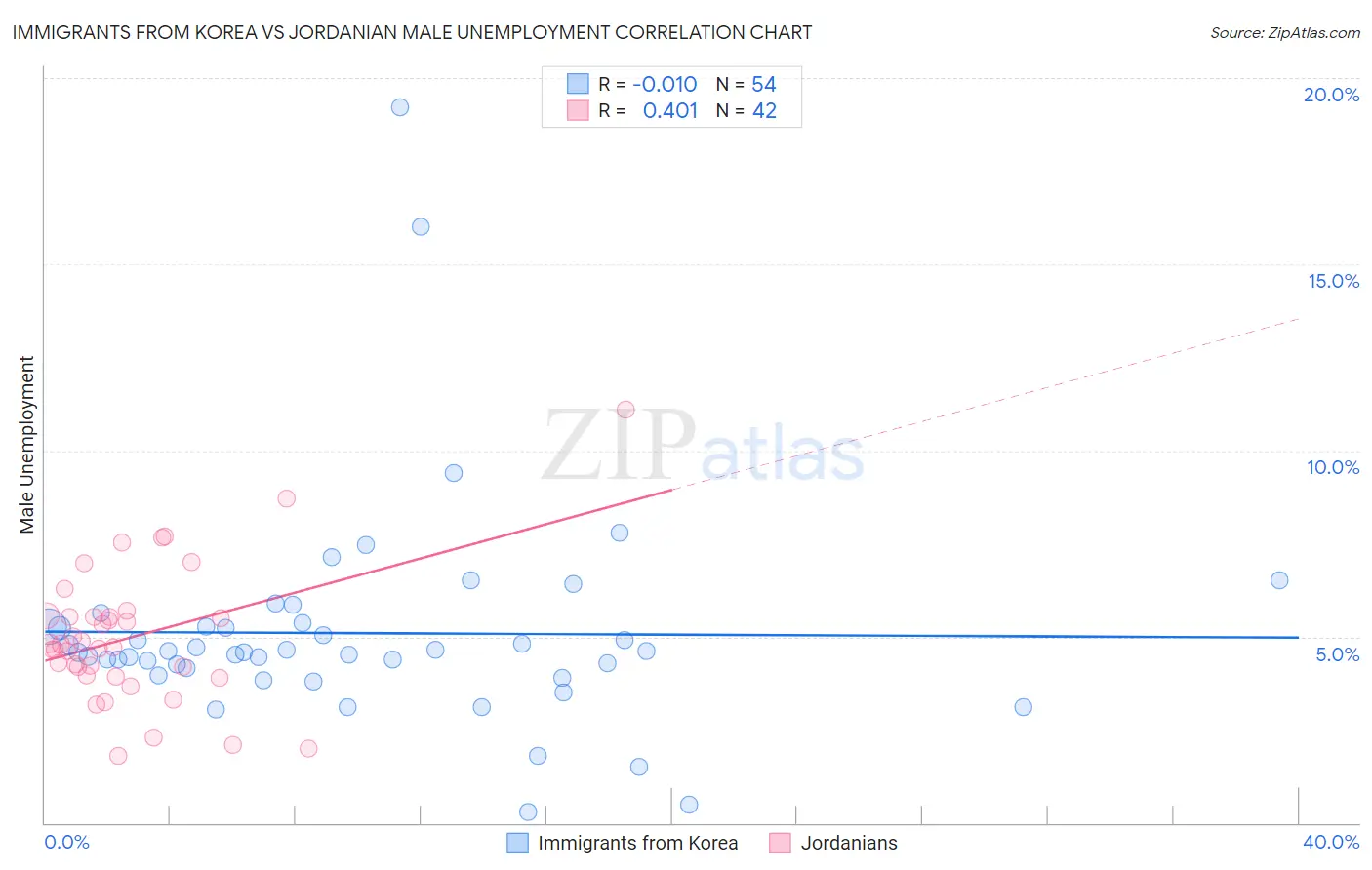Immigrants from Korea vs Jordanian Male Unemployment
COMPARE
Immigrants from Korea
Jordanian
Male Unemployment
Male Unemployment Comparison
Immigrants from Korea
Jordanians
4.9%
MALE UNEMPLOYMENT
99.1/ 100
METRIC RATING
44th/ 347
METRIC RANK
5.0%
MALE UNEMPLOYMENT
98.8/ 100
METRIC RATING
53rd/ 347
METRIC RANK
Immigrants from Korea vs Jordanian Male Unemployment Correlation Chart
The statistical analysis conducted on geographies consisting of 414,464,791 people shows no correlation between the proportion of Immigrants from Korea and unemployment rate among males in the United States with a correlation coefficient (R) of -0.010 and weighted average of 4.9%. Similarly, the statistical analysis conducted on geographies consisting of 166,295,233 people shows a moderate positive correlation between the proportion of Jordanians and unemployment rate among males in the United States with a correlation coefficient (R) of 0.401 and weighted average of 5.0%, a difference of 0.46%.

Male Unemployment Correlation Summary
| Measurement | Immigrants from Korea | Jordanian |
| Minimum | 0.30% | 1.8% |
| Maximum | 19.2% | 11.1% |
| Range | 18.9% | 9.3% |
| Mean | 5.1% | 5.0% |
| Median | 4.6% | 4.7% |
| Interquartile 25% (IQ1) | 4.2% | 4.0% |
| Interquartile 75% (IQ3) | 5.3% | 5.5% |
| Interquartile Range (IQR) | 1.1% | 1.6% |
| Standard Deviation (Sample) | 3.0% | 1.8% |
| Standard Deviation (Population) | 2.9% | 1.8% |
Demographics Similar to Immigrants from Korea and Jordanians by Male Unemployment
In terms of male unemployment, the demographic groups most similar to Immigrants from Korea are Immigrants from Zimbabwe (4.9%, a difference of 0.15%), Immigrants from Japan (4.9%, a difference of 0.18%), Bhutanese (4.9%, a difference of 0.24%), Immigrants from Belgium (4.9%, a difference of 0.29%), and Chinese (4.9%, a difference of 0.31%). Similarly, the demographic groups most similar to Jordanians are Irish (5.0%, a difference of 0.060%), Slovene (5.0%, a difference of 0.080%), Yugoslavian (5.0%, a difference of 0.10%), Croatian (4.9%, a difference of 0.11%), and Czechoslovakian (5.0%, a difference of 0.11%).
| Demographics | Rating | Rank | Male Unemployment |
| Immigrants | Bosnia and Herzegovina | 99.4 /100 | #38 | Exceptional 4.9% |
| Burmese | 99.3 /100 | #39 | Exceptional 4.9% |
| Northern Europeans | 99.3 /100 | #40 | Exceptional 4.9% |
| Chinese | 99.3 /100 | #41 | Exceptional 4.9% |
| Immigrants | Belgium | 99.2 /100 | #42 | Exceptional 4.9% |
| Immigrants | Japan | 99.2 /100 | #43 | Exceptional 4.9% |
| Immigrants | Korea | 99.1 /100 | #44 | Exceptional 4.9% |
| Immigrants | Zimbabwe | 99.0 /100 | #45 | Exceptional 4.9% |
| Bhutanese | 98.9 /100 | #46 | Exceptional 4.9% |
| Austrians | 98.9 /100 | #47 | Exceptional 4.9% |
| Immigrants | Scotland | 98.9 /100 | #48 | Exceptional 4.9% |
| Poles | 98.9 /100 | #49 | Exceptional 4.9% |
| Croatians | 98.9 /100 | #50 | Exceptional 4.9% |
| Slovenes | 98.8 /100 | #51 | Exceptional 5.0% |
| Irish | 98.8 /100 | #52 | Exceptional 5.0% |
| Jordanians | 98.8 /100 | #53 | Exceptional 5.0% |
| Yugoslavians | 98.7 /100 | #54 | Exceptional 5.0% |
| Czechoslovakians | 98.7 /100 | #55 | Exceptional 5.0% |
| Immigrants | Bulgaria | 98.7 /100 | #56 | Exceptional 5.0% |
| Turks | 98.5 /100 | #57 | Exceptional 5.0% |
| Lithuanians | 98.5 /100 | #58 | Exceptional 5.0% |